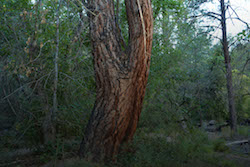 The Alternative Fuel Vehicle Roadshow is set to open June 15, 2015 in Gainesville, Georgia with an 8-city tour led by Georgia Public Service Commissioner Tim Echols. The series brings together a vehicle showcase and discussion panels on the practical impact of converting fleets to clean, alternative fuels like propane, E85, natural gas, electric (EV) and compressed natural gas (CNG). Questions on financing, safety, maintenance and fuel considerations of clean vehicle conversions will be answered by government fleet managers and private sector fleets, along with vehicle manufacturers and utilities who will highlight their success transitioning fleets, based on need and use.
The Alternative Fuel Vehicle Roadshow is set to open June 15, 2015 in Gainesville, Georgia with an 8-city tour led by Georgia Public Service Commissioner Tim Echols. The series brings together a vehicle showcase and discussion panels on the practical impact of converting fleets to clean, alternative fuels like propane, E85, natural gas, electric (EV) and compressed natural gas (CNG). Questions on financing, safety, maintenance and fuel considerations of clean vehicle conversions will be answered by government fleet managers and private sector fleets, along with vehicle manufacturers and utilities who will highlight their success transitioning fleets, based on need and use.- DNC Energy, an environmental firm focused on building renewable energy infrastructure, announced today that it has received major funding through a bond program to construct a waste wood and crop residue fired biomass electric generation plant in Ukraine’s Kyiv region. The 25 MW facility is the 13th biomass plant to be built in the Ukraine, which currently has six burning biomass plants and seven biogas anaerobic digester systems.
- Vermont Governor Peter Shumlin joined PSEG Solar Source, Encore Redevelopment, juwi solar Inc. and Vermont Electric Power Producers Inc. to dedicate the PSEG Essex Solar Center. The 3.6-megawatt-dc facility, located roughly four miles northeast of Burlington, VT, is the state’s largest solar farm.
- Canadian Solar Inc. has announced it closed a GBP35 million (US $53 million) project financing facility with Investec Bank plc, for a portfolio of four solar power plants with an installed capacity totaling 40.2 MW. Located at four different locations across England, the installations have been built under the Renewables Obligation regime and became operational in March 2015.
Solenis Launches Scale Inhibitor at #FEW15
 Solenis introduced a new scale inhibitor for ethanol plant evaporators at the 2015 Fuel Ethanol Workshop & Expo (FEW) in Minneapolis last week.
Solenis introduced a new scale inhibitor for ethanol plant evaporators at the 2015 Fuel Ethanol Workshop & Expo (FEW) in Minneapolis last week.
Solenis, a leading global producer of specialty chemicals, launched the Polystabil™ AS4535 scale inhibitor specifically designed to help fuel ethanol producers control scale in their evaporators, improving heat transfer and reducing downtime while still meeting regulatory guidelines for chemical usage.
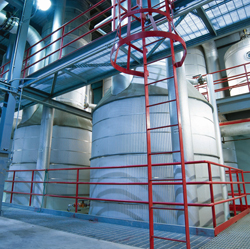 “Today’s fuel ethanol processes tend to generate more scale than ever before,” said Allen Ziegler, global biorefining marketing director. “This novel product performs significantly better than polyacrylate chemistries and allows fuel ethanol plants to split feed the chemistry, for example at the front of the evaporators to treat the whole system, and then with an additional dosage before problem areas, such as the evaporator where inorganics are concentrated. This results in improved heat transfer efficiency and a reduced need for cleaning and related downtime. Fuel ethanol operations using Polystabil AS4535 scale inhibitor are therefore able to maintain maximum efficiency while staying within regulatory limits.”
“Today’s fuel ethanol processes tend to generate more scale than ever before,” said Allen Ziegler, global biorefining marketing director. “This novel product performs significantly better than polyacrylate chemistries and allows fuel ethanol plants to split feed the chemistry, for example at the front of the evaporators to treat the whole system, and then with an additional dosage before problem areas, such as the evaporator where inorganics are concentrated. This results in improved heat transfer efficiency and a reduced need for cleaning and related downtime. Fuel ethanol operations using Polystabil AS4535 scale inhibitor are therefore able to maintain maximum efficiency while staying within regulatory limits.”
The new scale inhibitor represents one of many solutions recently developed for fuel ethanol producers by Solenis, which was previously known as Ashland Water Technologies. Other process and water treatment innovations include FDA-approved corn oil extraction aids for both disk-stack and tricanter systems; a proprietary control system that allows for around-the-clock surveillance and control of process and water treatment programs; a low-corrosion microbiocide for cooling water systems; and new antibiotic-free fermentation aids.
Iowa RFA Praises State Legislature
![]() As the Iowa Legislature wrapped up the 2015 legislative session last week, the Iowa Renewable Fuels Association (IRFA) praised several key pieces of legislation that were passed to expand use of higher ethanol and biodiesel blends.
As the Iowa Legislature wrapped up the 2015 legislative session last week, the Iowa Renewable Fuels Association (IRFA) praised several key pieces of legislation that were passed to expand use of higher ethanol and biodiesel blends.
Before the gavel went down on the 86th General Assembly, Iowa lawmakers passed key legislation that allows E15 infrastructure investments to become eligible for Iowa Renewable Fuels Infrastructure grants. Previously, the funds were only available for blender pumps and dispensers offering E85. Additionally, the Iowa legislature passed a bill that will establish a new grant program for fuel retailers to replace old underground storage tank (UST) equipment with new components that are UL listed to be fully compatible with E85.
“After a long, spirited session, we sincerely thank the Iowa Legislature for remaining committed to increasing the use and availability of higher ethanol and biodiesel blends,” stated IRFA Policy Director Grant Menke. “With an uphill climb for renewable fuels ahead in terms of federal policy, forward-thinking state initiatives are a must to continue to build upon the successes of Iowa’s nation-leading renewable fuels industry.”
Earlier in the session, the Iowa Legislature included a 3-cent per gallon differential tax rate for B11 and higher biodiesel blends in its road infrastructure legislation. Iowa RFA says this provision, which takes effect for five years on July 1, will help encourage the increased use and availability of higher biodiesel blends.
Novozymes Talks Fermentation at #FEW15
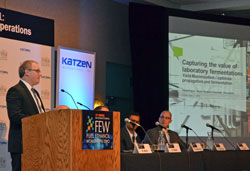 One of the most well-attended breakout sessions at the Fuel Ethanol Workshop last week in Minneapolis explored “Best Practices for Yield Maximization.”
One of the most well-attended breakout sessions at the Fuel Ethanol Workshop last week in Minneapolis explored “Best Practices for Yield Maximization.”
Novozymes research associate Derek Payne focused on propagation and fermentation optimization and getting data from small scale fermentations to find out what works. “By doing the smaller scale first you can predict patterns you would see in larger scale before implementing it,” said Payne who compares small scale fermentations to micro-breweries. “As technology gets better, we can more closely mimic what’s going on in the plant, in the lab itself.”
Novozymes offers lab services consulting and advanced laboratory seminars, depending on a plant’s needs. Listen to Derek explain more in this interview: Interview with Derek Payne, Novozymes
FPL and FIU to Build Solar Power Center
Florida Power & Light Company (FPL) and Florida International University (FIU) have solidified a partnership to build a commercial-scale distributed solar power facility that will both generate electricity for FPL’s 4.8 million customers and serve as an innovative research operation.
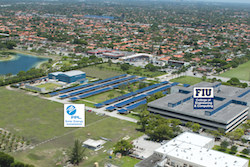
Artist’s conceptual rendering of the 1.6-megawatt solar installation FPL plans to install at Florida International University in 2015. The solar-powered parking canopies will also create about 600 shaded parking spaces in the parking lot of FIU’s Engineering Center. (PRNewsFoto/Florida Power & Light Company)
The project includes the installation of more than 5,700 solar panels on 23 canopy-like structures that will be built this summer in the parking lot of the university’s Engineering Center. Using data from the 1.6 MW solar array, faculty and students from FIU’s College of Engineering and Computing will study the effects of distributed solar photovoltaic (PV) generation on the electric grid in real-life South Florida conditions.
“This innovative solar project builds on FIU’s relationship with FPL, one that provides our students with unparalleled and unique training opportunities,” said FIU President Mark B. Rosenberg. “Through this project, our engineering students will make a direct contribution to the growth of solar energy in our state, while gaining invaluable experience working side by side with professionals from one of the most forward-thinking utilities in the nation.”
Eric Silagy, president and CEO of FPL noted, “FPL is proud to be a leader in advancing solar energy in smart ways, making sure to keep costs low and reliability high for our customers. As the economics of solar continue to improve, we look forward to harnessing more and more energy from the sun. Our partnership with FIU is designed to help us manage solar power’s interaction with the greater electric grid as part of our commitment to reliably deliver affordable clean energy for all of our customers.”
FIU students have already begun gathering information to be used in their research, including historical weather data and energy production and usage patterns. The research will take Florida’s unique weather conditions into consideration and help determine the types of technology that may be needed to ensure the grid’s reliability is not negatively affected by fluctuations in solar PV production due to clouds, thunderstorms and other variables.
BioEnergy Bytes
 SNC-Lavalin has announced that Transmission & Distribution (T&D) has been awarded a new project by BC Hydro and Power Authority to produce the design and provide project and construction management services for the new BC Hydro Meikle Wind Terminal—a 230-kilovolt (kV) switchyard located approximately 23 kilometres northwest of Tumbler Ridge in British Columbia, Canada. The new switchyard will serve as the point of interconnection to the BC Hydro power grid for the Meikle Wind Energy Project, a wind farm being developed in the Peace River region. The wind farm will provide approximately 180 MW of energy.
SNC-Lavalin has announced that Transmission & Distribution (T&D) has been awarded a new project by BC Hydro and Power Authority to produce the design and provide project and construction management services for the new BC Hydro Meikle Wind Terminal—a 230-kilovolt (kV) switchyard located approximately 23 kilometres northwest of Tumbler Ridge in British Columbia, Canada. The new switchyard will serve as the point of interconnection to the BC Hydro power grid for the Meikle Wind Energy Project, a wind farm being developed in the Peace River region. The wind farm will provide approximately 180 MW of energy.- Dairyland Power Cooperative has issued a request for proposals (RFP) for up to 25 MW of renewable energy from one or more new utility-scale photovoltaic solar facilities. The RFP seeks proposals from qualified bidders for up to 25 MW of capacity with commercial operation to begin by July 1, 2016. Dairyland is receptive to a variety of proposal options, including Dairyland ownership of new facilities, power purchase agreements (PPAs) or other arrangements, single or multiple sites.
- Bay Area Trash Compactor has announced the installation of the first-of-its-kind combination solar powered trash compactor and portable cardboard baler at the LEED Platinum Certified Bardessono Hotel and Spa in the Napa Valley, California. Completely off the grid, the solar powered compactor packs 16 yards of loose trash into just 4 yards, reducing waste pick-up at the busy property to just once per week.
- Intersolar North America, taking place July 14-16, 2015 in San Francisco, California, will feature intensive and in-depth panel discussions on the new financing models driving the market. This program features a special nine-session financing package, eight of them developed with the SunSpec Alliance, a trade alliance of more than 70 solar and storage distributed energy industry participants, as well as an additional panel focused on discussing the latest developments in U.S. solar policy that will impact financing.
Gevo’s Biojet Fuel Catches Air
Gevo’s technology to convert wood waste to biojet fuel has achieved a breakthrough in its fermentation technology and will soon “catch air” as its soars in the sky in test flights. The wood waste is first converted to isobuanol and then converted into alcohol-to-jet fuel.
Gevo has an operational plant in Luverne, Minnesota that has flexible feedstock technology allowing the plant to produce isobutanol from multiple feedstocks. In the past the primary feedstock has been corn and the resulting fuel has been tested by airlines and the U.S. military in their planes. This new process uses forest residues. Removing waste helps to prevent forest fires.
According to the company, they have adapted their patented Gevo Integrated Fermentation Technology(R) (GIFT(R)) to convert the cellulosic sugars from wood into renewable isobutanol. They then use their patented hydrocarbon technology to convert the cellulosic isobutanol into alcohol-to-jet-synthetic paraffinic kerosene (ATJ-SPK) fuel.
“There are significant economic and environmental benefits of renewable jet fuel, which makes it a great market for Gevo. This announcement demonstrates the flexibility of our technology and reinforces our technology leadership,” said Dr. Pat Gruber, Chief Executive Officer of Gevo, Inc. “The next two milestones for renewable jet fuel are the approval by ASTM and the scheduled commercial test flights. Our team is actively engaged in both of these activities.”
Gevo’s cellulosic isobutanol production will be conducted at a demonstration facility in St. Joseph, MO, that the company jointly operates with ICM Inc. The ATJ-SPK will be produced in Silsbee, Texas, at the demonstration facility the company operates with South Hampton Resources.
The company is a member of the Northwest Advanced Renewables Alliance (NARA) and is providing the organization with technology to enable the commercial scale processing of cellulosic sugars from wood waste into valuable products. The cellulosic jet fuel made using Gevo’s technologies will be used in a 1,000-gallon renewable fuel demonstration test flight that NARA announced yesterday in conjunction with Alaska Airlines. Gevo’s isobutanol and ATJ-SPK technologies are both planned to be licensed by NARA as part of this project.
Ralph Cavalieri, director of NARA, added, “We’re encouraged by Gevo’s work with the NARA team in converting Pacific Northwest forest residual biomass into jet fuel, and look forward to working with them on this test flight and in the next phases of the commercialization of this technology.”
Ethanol Industry Thoughts on Presidential Candidates
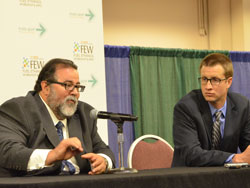 Several new presidential hopefuls in both parties have officially declared their candidacies recently and more are planning to announce soon. During a press briefing at the 2015 Fuel Ethanol Workshop, Bob Dinneen with the Renewable Fuels Association and Brooke Coleman with the Advanced Ethanol Council were asked how they think the candidates, declared and undeclared, rate when it comes to the Renewable Fuel Standard.
Several new presidential hopefuls in both parties have officially declared their candidacies recently and more are planning to announce soon. During a press briefing at the 2015 Fuel Ethanol Workshop, Bob Dinneen with the Renewable Fuels Association and Brooke Coleman with the Advanced Ethanol Council were asked how they think the candidates, declared and undeclared, rate when it comes to the Renewable Fuel Standard.
Dinneen attended the Iowa Ag Summit in March where nine Republican presidential hopefuls were asked their views on the RFS and was not surprised that the only two who said they were opposed were from Texas – the first declared GOP candidate Sen. Ted Cruz and former Gov. Rick Perry, who just formally declared this week. “That’s a dog bites man story if there ever was one,” said Dinneen. “I would think less of those two men if they weren’t sticking up for their big Texas oil industry.”
Dinneen was surprised by the candidates who did express support for the RFS, some of them publicly for the first time, including former Florida Governor Jeb Bush, who is expected to announce his candidacy later this month, New Jersey Gov. Chris Christie and Wisconsin Gov. Scott Walker, both of whom have yet to declare.
On the Democratic side, another new candidate announced this week was former Rhode Island governor Lincoln Chafee, but the big dog in the fight is still Hillary Clinton and Coleman was impressed with her recent op-ed in the Cedar Rapids Gazette. “It suggested that she understands the different intricacies of the challenges we face in this industry,” said Coleman. “However, one op-ed does not make a candidate and we will have to continue to work with Secretary Clinton to make sure that she is helpful to make sure she is helpful with regard to what we are dealing with in the administration right now because there is no better person to help us than Hillary Clinton when it comes to where the Obama administration is in the Renewable Fuel Standard.”
Listen to Dinneen and Coleman here: Comments from RFA's Bob Dinneen and AEC's Brooke Coleman at FEW
Novozymes Ethanol Game Educates at #FEW15
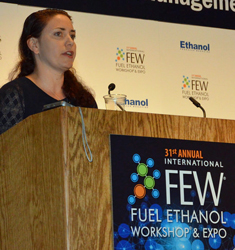 “Gamification” is the concept of applying game-design thinking to non-game applications as engaging learning tools, particularly for the younger generation and Novozymes had a great example on display at the 2015 Fuel Ethanol Workshop.
“Gamification” is the concept of applying game-design thinking to non-game applications as engaging learning tools, particularly for the younger generation and Novozymes had a great example on display at the 2015 Fuel Ethanol Workshop.
The Ethanol Challenge game features characters like Alphie the alpha amylase, Glucador the glucoamylase, and a number of enzyme buddies who help them out throughout the ethanol production process as they navigate through dangerous doughballs and bacteria. Rachel Burton with Novozymes says the Ethanol Challenge is their foray into gamification as part of a training program they have developed called Bioenergy University. “We’re launching that this summer for our customers,” said Burton. “We have three tiered learning tracks – a basic beginner track, an advanced track, and we have an expert level track.”
Rachel explains more in her FEW presentation on “Next Generation Training for Ethanol Plants.” Rachel Burton, Novozymes, at 2015 FEW
Watch Rachel demonstrate the Ethanol Challenge game in this video:
Lallemand Makes #FEW15 Fashion Statement
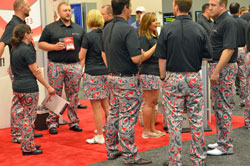 Lallemand Biofuels and Distilled Spirits really stood out at the opening of the 2015 Fuel Ethanol Workshop trade show with logo patterned pants that were definitely attention-getting.
Lallemand Biofuels and Distilled Spirits really stood out at the opening of the 2015 Fuel Ethanol Workshop trade show with logo patterned pants that were definitely attention-getting.
“We just decided we wanted to try something a little bit different and stand out a little bit,” said Lallemand VP of Marketing Craig Pilgrim, who came up with the idea. “I looked on line and saw some crazy, swirly pants and said we could probably incorporate our logo in there and figured most people wouldn’t be wearing that the night of the trade show.”
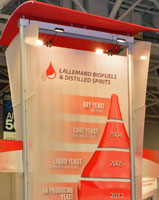 The crazy pants helped draw attention to the fact that Lallemand is celebrating its 35th Alcohol School this year in Montréal September 13-18. “Started off very small, 10 or 12 people in a room,” said Pilgrim. “We have roughly over 4,000 people that we’ve educated over the 35 years.”
The crazy pants helped draw attention to the fact that Lallemand is celebrating its 35th Alcohol School this year in Montréal September 13-18. “Started off very small, 10 or 12 people in a room,” said Pilgrim. “We have roughly over 4,000 people that we’ve educated over the 35 years.”
The course provides detailed information on both fuel ethanol and beverage alcohol unit processes and is designed for lab, plant, and management personnel with lectures, laboratory demonstrations, seminars, and lab visits. Find out more in this interview: Interview with Craig Pilgrim, Lallemand



